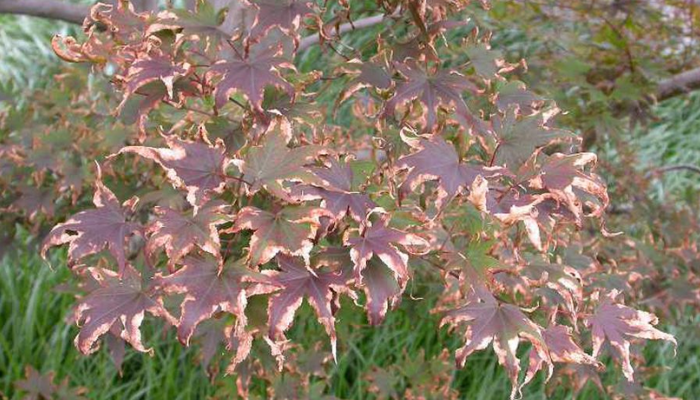Japanese maple trees are beloved for their unique foliage and stunning fall foliage, and they are popular ornamental trees in many gardens. However, when it comes to watering, these trees require special care and attention, as overwatering can lead to serious health issues. In this article, we will explore the signs and symptoms of Japanese maple overwatering, as well as discuss ways to prevent this problem.
What is Japanese Maple?
Japanese Maple is a species of deciduous tree native to Japan, Korea, and parts of China. With its beautiful foliage, it’s a popular choice for landscaping and gardens. The tree is also known for its stunning red and yellow foliage in the fall.
However, with any tree, it’s important to be mindful of overwatering symptoms. Too much water can be detrimental to its health, leading to a number of issues. The most common symptoms of Japanese Maple overwatering are wilting, yellowing, and browning leaves, as well as stunted growth.
Wilting can be caused by root rot, a fungal infection that is the result of too much moisture in the soil. Roots will become waterlogged and no longer able to uptake the necessary nutrients. Yellowing and browning leaves are also symptoms of overwatering and can indicate the tree is not getting enough oxygen.
Stunted growth is usually caused by a combination of root rot and low oxygen levels, preventing the tree from taking in the nutrients it needs to grow.
What are the Symptoms of Overwatering?
Overwatering a Japanese Maple can cause serious damage to the tree. The most common symptoms of overwatering include yellowing of the leaves, wilting, and root rot. The leaves of the Japanese Maple may start to turn yellow and drop prematurely.
Wilting of the leaves may also occur, as the tree is unable to absorb the water that is flooding its root system. Root rot is a serious issue that can occur when a Japanese Maple is overwatered.
Root rot can be identified by a foul odor and dark brown or black roots. If root rot has taken hold, it is important to take immediate action, as root rot can be fatal to the tree.
How to Avoid Overwatering?
Overwatering your Japanese Maple can cause a lot of problems for your tree. Too much water can cause the roots to rot, which in turn can cause the leaves to become wilted and discolored. In severe cases, the leaves may even begin to drop off the tree.
To avoid overwatering your Japanese Maple, it’s important to make sure it has good drainage. Planting it in a well-draining soil mix is essential. Additionally, you should avoid overwatering your Japanese Maple by only giving it water when the top layer of soil is dry.
This will help ensure the roots get the water they need without becoming waterlogged. If you have an irrigation system, you should also make sure it is set up properly to avoid overwatering.
Finally, it’s also important to keep an eye on the weather. If it’s been raining a lot, you may not need to water your Japanese Maple as much as you usually do.
Treatments for Overwatering
Treating Japanese Maple trees that have been overwatered can be a tricky process. The first step is to reduce the amount of water that the tree receives; this can be done by either reducing the frequency of watering or by using a soaker hose to deliver water to the tree’s roots without soaking the foliage.
Additionally, it is important to add a layer of mulch around the tree, as this will help retain moisture and keep the soil aerated. Finally, it is important to check the soil around the tree for any signs of root rot or fungus, as these can be indicative of overwatering.
If root rot is detected, it is important to treat the area with an antifungal agent and to repot the tree in fresh soil. Taking these steps will help the Japanese Maple tree to recover from overwatering.
Prevention is Better Than Cure: Stunning Alternatives To Japanese Maple Trees
Prevention is better than cure, and this is especially true when it comes to Japanese Maple trees and overwatering. If you are considering planting a Japanese Maple but are worried about overwatering, landscaping with stunning alternatives is a great option.
There are many trees and shrubs that can be used to create a beautiful landscape without the risk of overwatering. Choices that can provide privacy, vibrant foliage, and other features that Japanese Maples are known for.
Alternatives such as Oaks, Spruces, and Magnolias can all provide a stunning landscape without the risk of overwatering. These trees are all resilient and can be planted in a wide variety of climates.
Conclusion
Japanese Maple trees are a beautiful and delicate addition to any garden or landscape. Although they are relatively easy to care for, they are sensitive to overwatering and can suffer from a variety of symptoms.
These symptoms can range from yellowing leaves, root rot, and root death to leaf drop and discoloration. If you notice these symptoms, it is important to take action immediately to reduce the amount of water given to your tree and to ensure it is getting proper drainage. With the right care and attention, your Japanese Maple tree can continue to thrive in your garden or landscape.

















Comments